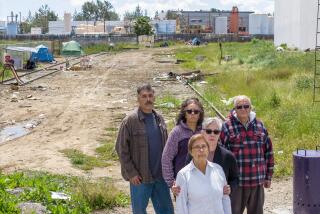State Officials to Levy Fine for Napalm Leaks at Fallbrook Navy Station : Bombs: Navy says there is no health hazard from the Vietnam War-era weapons, which are scheduled for disposal.
- Share via
State health officials Wednesday said they have ordered the Navy to assess what problems may have been created by leaking napalm bombs stored at the Fallbrook Naval Weapons Station. Health authorities also announced their intent to levy a $20,000 fine against a private company hired by the Navy to recycle the Vietnam War-era napalm.
The state Department of Health Services’ order perplexed a Navy spokesman, who said that the problem of leaking napalm--a flammable, sticky mixture of polystyrene plastic, gasoline and benzene--has been monitored for years, and there are no signs of a health risk.
The project manager of the private napalm-recycling firm said he corrected the technical deficiencies of his operation within days of an inspection last summer and said the prospect of a $20,000 fine, nearly five months later, is excessive.
A spokesman for the health department said both the Navy and Palm Enterprises, the Monrovia-based company hired by the Navy to dispose of the 2.7-million gallons of napalm, will have the opportunity to appeal the findings.
Both the Navy and Palm Enterprises said they will.
The focus of the state’s complaint stems from a July 20 inspection that detected leaks from several of the more than 33,000 napalm canisters stored at the weapons annex, said Allan Hirsch, a spokesman for the department’s toxic-waste substance division in Long Beach. The canisters do not contain the detonation devices they are armed with when used as bombs.
It was not known whether the residual material is creating a health problem--and that’s what the health department wants the Navy to find out, Hirsch said.
“We certainly don’t feel there’s an eminent health risk--nothing that would require an emergency action--but we still want an assessment of any possible health risk,” he said.
The Air Force-owned napalm was deposited at the Naval Weapons Station in 1973, when it was a staging area for munitions during the Vietnam War. It was left there for the Navy to deal with at the war’s conclusion.
Navy officials tried unsuccessfully twice to have the napalm removed by private companies before contracting with Palm Enterprises in 1987 to recycle the napalm on site.
The company hired Ike Scheinbaum, a petrochemical engineer, to serve as the project manager in designing, building and operating a recycling plant that would break down the napalm into its three major components, for commercial resale.
The company said it would pay the Navy $10,000 for the napalm; the Navy said it was glad just to get rid of the stuff.
A host of federal, state and county environmental protection agencies have since monitored Palm Enterprises’ progress in testing the plant, which has yet to go into production.
The state cited Palm Enterprises for not having a toxic-waste warning sign at the site in Spanish, for not having completed a 1988 annual report on its operation and for not having updated the time frame of when the recycling operation is expected to be completed.
Hirsch acknowledged that each complaint was rectified within days of the initial notification, “but it’s our practice to still go ahead and cite somebody,” even after the problem is corrected.
Hirsch said some of the proposed fine is for the Navy not having contained the leaking napalm, but that, since the Navy can’t be sued, the state targeted Palm Enterprises instead.
Navy officials say they have been monitoring the leakage for air pollution and ground-water contamination since it was noticed by the Navy and publicly disclosed in late 1981.
The Navy hired a private air-quality consulting firm to monitor the air and ground water around the three napalm storage sites for signs of benzene and hydrocarbons, said Cmdr. Doug Schamp, a Navy spokesman.
Furthermore, the San Diego County Air Pollution Control District has established monitoring devices around the napalm canisters.
Neither the APCD nor the private firm has found levels of benzene or hydrocarbons beyond the ambient level that would be found “in an industrial area or in city traffic, and the level is certainly lower than you’d find at your neighborhood gas station,” Schamp said.
The state health department’s notice was delivered to the Navy on Tuesday, Schamp said, “and it was a total surprise to us. The things (the inspector) said we should be doing to monitor the problem are things we’d been doing for years,” Schamp said.
“Now, we’ve got to have our lawyers put something together to tell them, ‘Hey, we are in compliance.:’ ”
The leaking canisters, perhaps caused after wooden pallets broke down and canisters shifted, plugged themselves, Schamp said, because, as the leaking gasoline and benzene evaporated when exposed to air, the remaining plastic hardened in the hole.
None of the canisters are currently leaking.
“There were no signs of napalm even leaking onto the ground,” he said, “and certainly we’re not talking about hundreds of pounds of napalm on the ground.”
Scheinbaum, meanwhile, said the recycling operation, which involves a distillery of sorts to separate the benzene and the gasoline, and an extruding device to remove the plastic material, is still being tested. The plant, he said, is a one-of-a-kind operation “and what we’re trying to do has never been practiced before.”
“We’re doing research and development while we go,” he said, “and it’s taking a lot of patience and a deep pocket as well.”
More to Read
Sign up for Essential California
The most important California stories and recommendations in your inbox every morning.
You may occasionally receive promotional content from the Los Angeles Times.













